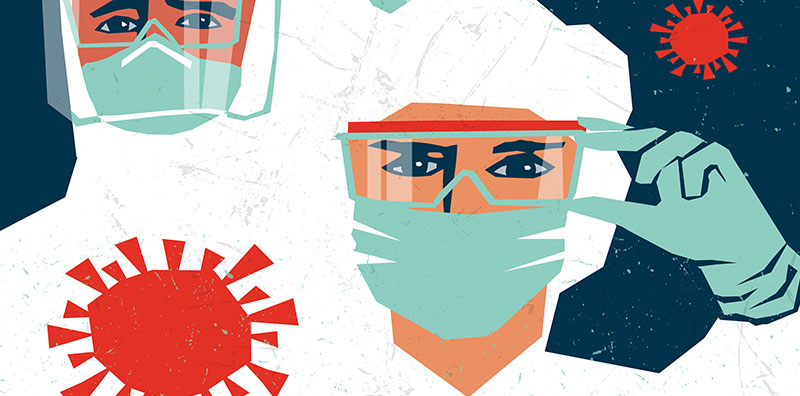What was it like to be in the shoes of Grinnellians as the coronavirus pandemic accelerated? Here, in their own words, they share their experiences.
“Included in my current tasks? Notifying people that their COVID-19 test is positive.”
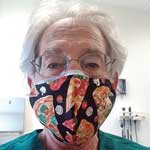 Don Kraitsik ’70 practices family medicine at Gallup Indian Medical Center in Gallup, New Mexico.
Don Kraitsik ’70 practices family medicine at Gallup Indian Medical Center in Gallup, New Mexico.
My usual outpatient care of longtime patients — Navajo, Zuni, Apache — has been totally disrupted. I spend hours on the phone doing a variation of telemedicine. Many patients have no phone, poor service, no answering machine, no texting. Some are homeless. When I finally do make contact with them, they are suspicious at first, thinking I might be a bill collector. I have to convince them who I am.
The Navajo Nation has been hit hard by the coronavirus. On a per capita basis, the Navajo Nation has surpassed New York and New Jersey. When sheltered at home, many Navajo people have no running water (making hand-washing difficult) and many people live together in multi-generational large family groups. If one family member gets the coronavirus, everyone in the family gets exposed.
I have been asked to serve on an oversight committee regarding ventilator rationing if we come to a major surge and need to make moral and ethical decisions about who gets a ventilator. I have previously taken care of patients with tuberculosis and hantavirus. I think the coronavirus is unlike any other disease I have ever faced in its overwhelming threat to all humans.
I am not on the front lines seeing sick COVID-19 patients in consideration of my age. Many of my younger colleagues are spending long days in full personal protective equipment providing quality medical care for very sick patients. I salute, applaud, and honor all health care workers everywhere who are on the front lines.
“We had necessary conversations about what we each would accept for end-of-life care.”
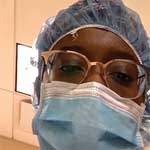 Juliet Mushi ’05 is an assistant professor in the department of obstetrics, gynecology, and reproductive sciences at Yale School of Medicine and is an attending physician
Juliet Mushi ’05 is an assistant professor in the department of obstetrics, gynecology, and reproductive sciences at Yale School of Medicine and is an attending physician
in the division of maternal-fetal medicine at Yale New Haven Health System/Greenwich Hospital. She lives in Harlem, New York.
My husband, Grant, and I had always talked about signing health care proxies and a living will, particularly after we had our baby, Kanaeli, last year. But in the busy-ness of everyday life, it always ended up on the bottom of the to-do list.
The beginning of the pandemic brought on a deep fear and uncertainty on my part. It was important to me that family members had clarity and certainty about our wishes.
It prompted us to finally get those papers signed and have necessary conversations about
what we each would accept for end-of-life care.
When it became clear that the situation in New York City was serious, we encouraged our childcare provider to stay home with her family while earning her salary. That meant Grant took on primary childcare responsibilities on top of having to work from home. Meanwhile, I was working full time at a hospital job.

It was challenging for both of us. We are both very career-oriented and have strong and independent personalities. But we learned again how to lean on each other during that time. We now celebrate date night at home every Saturday by ordering food, sharing our highs or lows from the week, and drinking divine cocktails made by Grant.
What keeps me going? Grant and Kanaeli, supportive check-ins from family and friends, the
7 p.m. cheer for essential workers, Afrobeats playlists, and meditation and yoga apps.
“I was up at 3 a.m. each night combing through the published literature.”
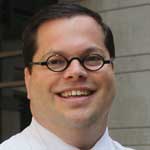 Michael Ison ’93 is a professor in the divisions of infectious diseases and organ transplantation at Northwestern University Feinberg School of Medicine.
Michael Ison ’93 is a professor in the divisions of infectious diseases and organ transplantation at Northwestern University Feinberg School of Medicine.
My research focuses on respiratory viruses. I’ve been tasked with being the chair of the data and safety committee for the National Institutes of Health’s COVID-19 clinical trial. I’m a member of the Feinberg School of Medicine COVID-19 Task Force.
When the first cases in Italy and Iran were announced, I was convinced that a pandemic was upon us. We began work to convert some of our standing research projects focused on respiratory viruses to include COVID-19 so we could quickly start work on these studies.
As the epidemic began affecting our medical center, I had a week when I was busier than I had ever been. I was balancing working in our COVID-ICU with efforts to get our research up and running and putting in place a program to get our sickest patients access to an experimental drug to treat the infection. I was multitasking and working 16-hour days only to go home and continue working from home. I was up at 3 a.m. each night combing through the published literature and Twitter.
My day is spent working on Zoom and Microsoft Teams calls. When I’m not on call, I’m troubleshooting research problems for things we would never think about before. Where can we see the patients who are infected with a virus that we strive to keep away from our other patients? How do we get consent when the signed form is infectious?
I know that with the work we are doing, we will have a better understanding of SARS-CoV-2 and its impact on our patients. Being involved with a team focused on cutting-edge care and providing access to novel therapies (and vaccines soon, I hope) to our patients is very rewarding.
”My mask sometimes frightens my pediatric patients.”
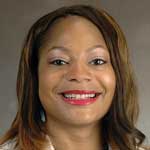 Rhashedah Ekeoduru ’03 is a pediatric anesthesiologist and associate professor of anesthesiology at McGovern Medical School at UTHealth.
Rhashedah Ekeoduru ’03 is a pediatric anesthesiologist and associate professor of anesthesiology at McGovern Medical School at UTHealth.
The onset of the COVID-19 pandemic was frightening for me, because my role as an anesthesiologist requires me to get close to patients’ faces to assist their breathing, place breathing tubes, and manage their tracheostomies. I am very high risk for contracting COVID-19.
Many physicians and I began wearing N95 masks throughout the entire workday. It is very difficult to breathe naturally while wearing these masks, and they can cause tension headaches. We previously only wore these masks when caring for patients afflicted with tuberculosis, so supplies were limited and dwindled quickly.
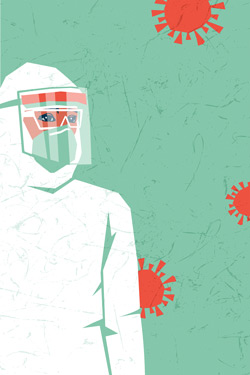 To protect ourselves, many of us sought assistance from friends and family members who had access to N95 masks. We also wore masks obtained from hardware stores.
To protect ourselves, many of us sought assistance from friends and family members who had access to N95 masks. We also wore masks obtained from hardware stores.
Today, high-risk personnel like me have been fit-tested for special N100 masks fashioned with high-efficiency air filters.
One downside is that they sometimes frighten my pediatric patients, so I have had to get very creative in order to provide a safe and comfortable clinical environment for them. We also are required to place plastic sheets over patients’ faces prior to any airway intervention. This is a change in practice and requires imagination and finesse for success.
I typically tell my kiddos that we are pretending as though we are going to go camping. One of the camp activities is to “blow up the balloon” — the anesthesia mask and circuit that will put them to sleep for the procedure. I am proud of how my colleagues and I stood strong, adapted, and collaborated during an unprecedented and unexpected crisis.
Everyone has the same common challenge right now, so we are doing our best to uplift each other’s spirits. I focus on maintaining my health and wellness by staying active (I purchased a Peloton at the start of the pandemic) and maintaining my creativity through painting. I have also taken advantage of some of my newfound free time by writing papers on the importance of ethical practice in medicine.
I am optimistic that a vaccine will become available within the next year that will allow us to regain a sense of normalcy and peace.
“I feel for my patients who are in health care or work in grocery stores. Their fear is palpable.”
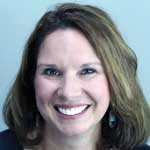 Robin Cook Kopelman ’95 is a perinatal psychiatrist and women’s mental health specialist in private practice and an adjunct associate professor at the University of Iowa College of Medicine.
Robin Cook Kopelman ’95 is a perinatal psychiatrist and women’s mental health specialist in private practice and an adjunct associate professor at the University of Iowa College of Medicine.
I did telemedicine for almost four years, providing specialized women’s mental health services in northwestern Iowa. Recently I made a transition to private practice and was excited to be returning to providing in-person care.
On Tuesday, March 10, my son, a first-year student at Grinnell, texted me that students would not be returning to campus after spring break. Grinnell’s early response was a catalyst for our group being prepared to hit the ground running with telehealth before it became a necessity. At the time, we thought we were being cautious, but it really meant we were ready to do telehealth when it seemed an important option just a week later.
I miss seeing patients in person in my office. Having experience with telemedicine has really prepared me for this moment. I know how to troubleshoot technical problems, I know how to set up my background, and, specifically for my field, I know how to accommodate for not being able to see the patient’s entire body and losing the input that your sense of smell provides.
Because I work with patients in their homes, their connectivity isn’t always the best, so we run into more disruptions than in our usual care, for sure. My favorite disruption, though, isn’t a bad one — I love seeing my patients’ children and pets.
For many, the pandemic has been a welcome slowing of a busy life that created a different kind of stress for them. This is especially true for my patients who are anxious about leaving their house or being around people. Others don’t feel so alone, now that “everyone is anxious.” This shared experience can be unifying and equalizing.
“There will be no easy solution.”
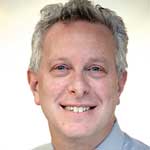 Scott Fridkin ’86 is a professor of medicine and epidemiology in the division of infectious diseases, the departments of medicine and epidemiology at Emory University.
Scott Fridkin ’86 is a professor of medicine and epidemiology in the division of infectious diseases, the departments of medicine and epidemiology at Emory University.
I left the Centers for Disease Control (CDC) about four years ago after 23 years working in outbreak response, mostly related to preventing health care-associated infections and health care worker safety, which included pandemic planning.
Now I teach emerging infectious diseases at the Rollins School of Public Health at Emory University in Atlanta. In the third week of January, I was responding to several of my invited guest lecturers from the CDC, which is across the street from Emory. That afternoon, I received a call from a friend who used to work for Delta and now operates a small airline. He asked if this was going to be a big thing, as he has called me during the Ebola, SARS, and H1N1 pandemics. In those times I often talked in generalities and nuanced responses. This time, I just replied, “Yes, this is the real thing. There will be no easy solution.”
In my course, rather than juggle guest lecturers and move planned talks around, I opened up three weeks to running workshops about COVID-19, working in real time to share how the government can and should respond to this pandemic. Needless to say, we didn’t simulate how the CDC would be sidelined nor how much poor information and inconsistent policy choices would influence the pandemic in the United States.

My classes have ended now. Today, work includes visiting nursing homes to help them with infection control. I help them manage their residents and interactions with acute care hospitals. I also am launching research initiatives focused on assessing health care worker risk for COVID-19.
“Our group diagnosed and cared for California’s first known COVID-19 patient.”
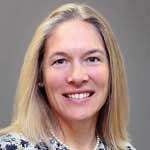 Christine Thorburn ’92 is interim CEO and board chair of the Palo Alto Foundation Medical Group part of the not-for-profit Sutter Health system.
Christine Thorburn ’92 is interim CEO and board chair of the Palo Alto Foundation Medical Group part of the not-for-profit Sutter Health system.
In late January, our group diagnosed and cared for California’s first known COVID-19 patient, who had been a business traveler from China.
That gave me pause, because we live and work in Silicon Valley, where there are many, many business travelers between China and California. However, the point when I realized our work and lives would fundamentally change was the day the news reported a clear community-acquired case of COVID-19 in our local area. At that point, our triage of patients into our offices for care needed to change dramatically.
We rapidly escalated a plan to divide our physical clinics into “respiratory clinics” and “other care” urgent clinics. At the same time, we developed de-escalation plans for all of our ambulatory and clinical practice patients, which we needed to do to limit physical exposure of other non-urgent patients.
We needed new methods of caring for patients. Our larger system had been working on a video-visit project, which we had hoped to roll out over two years as the private insurance companies and possibly Medicare changed their agreements to allow payment for them.
Medicare said “yes” to paying for almost all care-by-video visits (except procedures and surgeries, of course) by mid-March. Within 10 days, our system rolled out a plan to allow for video visits not only for my medical group, but for all six medical groups within Sutter Health.
We are still working out the kinks, but it is humbling to see not only my clinician colleagues adapting but also our patients, including 80-year-olds using smartphones or computers with cameras.
I am motivated to work with my colleagues to develop the “new normal” way of caring for patients to remain as safe as possible, both for patients and for providers. We will need to remain vigilant about the easy spread and asymptomatic presentation of this novel virus.
What have I learned? Humans are capable of adapting to much more rapid change than we usually feel comfortable making.
“I had been in a lab at least twice a week since I was 17.”
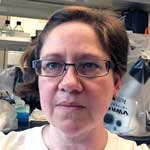 Aurora Burds Connor ’96 is director of the preclinical modeling and testing facilities at the Koch Institute for Integrative Cancer Research at MIT.
Aurora Burds Connor ’96 is director of the preclinical modeling and testing facilities at the Koch Institute for Integrative Cancer Research at MIT.
On Saturday, March 14, the president of MIT announced that noncritical research would stop. Only one of my projects was considered critical, so I needed to terminate everything else.
I had already told my staff to stay home earlier that week, so I was alone when I realized that I would not be doing hands-on research on a regular basis. This thought was disorienting and destabilizing. I have wanted to be a scientist since I was 9. Other than my semester abroad at Grinnell and the birth of my two children, I had been in a lab at least twice a week since I was 17.
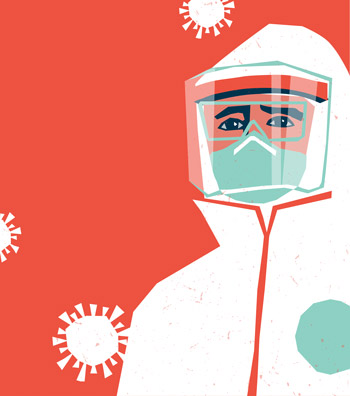 The lab I was standing in was a space that I had spent years designing when our new building was built. This is my dream job, and this lab is my home. I took a deep breath and quickly boxed up a small microscope so I could at least dissect plants and bugs with my kids, knowing it was a Band-Aid for the loss I was feeling. I took a selfie next to my favorite microscope.
The lab I was standing in was a space that I had spent years designing when our new building was built. This is my dream job, and this lab is my home. I took a deep breath and quickly boxed up a small microscope so I could at least dissect plants and bugs with my kids, knowing it was a Band-Aid for the loss I was feeling. I took a selfie next to my favorite microscope.
Today, I am a consultant for SARS-CoV-2 and COVID-19 research projects and testing initiatives. Like most universities, MIT does not have a space for work with infectious materials like this coronavirus, so there is no option for me to test any of the therapies my colleagues are developing. Instead, I assist with regulatory paperwork that must be approved before any preclinical or clinical trials can begin.
“Thank goodness for virtual backgrounds.”
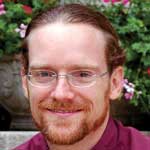 Nathaniel Hopkins ’98 is a senior staff psychologist and coordinator for information and systems for the University of Kentucky Counseling Center.
Nathaniel Hopkins ’98 is a senior staff psychologist and coordinator for information and systems for the University of Kentucky Counseling Center.
On Monday, March 2, I was wolfing down lunch and reading a Facebook post about what people thought about the news that COVID-19 was coming and what we were doing to get ready for quarantine.
The post gave me a moment of, “Oh crud, if someone is going to make things work in my office for this, it is me.” That is what I do in my job: think through all the ways things can go wrong so we can build ethical systems of practice.
I have spent a lot of my work time since then building out tech solutions to be able to do our work remotely. One of the biggest challenges is that health care provider licensure is fragmented both by state and by credential. The result is we are unable to continue to provide therapy to our students who have gone home to 49 other states and multiple other countries.
It has been really awful to say to a student, “Sorry you were forced to go home to Cincinnati, an hour away. I can’t continue to provide therapy to you because you’re not in Kentucky.”
My spouse and I, both psychologists in our counseling center, both need to be doing confidential therapy sessions at the same time, all while our kids are also trying to do remote school work. Every space in our house has become a meeting room. Thank goodness for virtual backgrounds.

“We wear face masks everywhere in the building.”
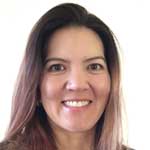 Michelle Raymer Joy ’96 is vice president and chief operating officer of Carson Tahoe Health system in Carson City, Nevada. Carson Tahoe Health is a not-for-profit health care system consisting of two hospitals, two urgent cares, an emergency care center, outpatient services, and a clinic provider network.
Michelle Raymer Joy ’96 is vice president and chief operating officer of Carson Tahoe Health system in Carson City, Nevada. Carson Tahoe Health is a not-for-profit health care system consisting of two hospitals, two urgent cares, an emergency care center, outpatient services, and a clinic provider network.
A typical workday in the office now is a temperature check, screening questions, and use of hand sanitizers in order to enter the building. We wear face masks everywhere in the building and in all meetings with more than two people.
More than 75% of the day is spent on COVID-19-related items. We have spent time on surge planning for a potential influx of patients, increasing our bed capacity from 181 beds to 481 beds. This includes making sure we have enough staff, physicians, ventilators, other equipment, and PPE [personal protective equipment] to take care of this influx
of patients.
As we have suspended elective surgeries and other non-emergency services, we have redeployed staff and are retraining others to new areas to help with a surge in patients. There has been a tremendous amount of detail in the surge plan. Where do COVID-19 patients get placed? Where do non-COVID-19 patients get placed? What about emergency surgeries and birth and deliveries? How do we increase our traditional ventilator capacity from 22 to 60? What is the morgue capacity? How do we implement crisis care standards? How do we take care of staff now and during a surge?
Health care is a calling. Everyone continues to show up each day willing to do whatever is needed.
Our frontline employees and first responders are true heroes.
“I see patients take their last breath without those who love them surrounding them.”
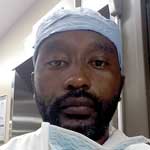 Bethwel Raore ’01 is a neurosurgeon in North Atlanta, Georgia.
Bethwel Raore ’01 is a neurosurgeon in North Atlanta, Georgia.
In mid-March, we all knew COVID-19 was starting to ravage the country. My hospital was already seeing patients, but because I’m not a pulmonary critical care or infectious disease physician, I didn’t quite see myself as a frontline worker. All the elective surgeries were stopped. All we did were cases of brain and spine trauma or cancer — those that couldn’t wait.
One evening, when I was on call for neurosurgical trauma, there was a major accident on the interstate. I came in to evaluate a patient who had multiple spine fractures from that accident. His fractures threatened disability, so we had to rush him to the operating room. I knew the patient was from an accident, so I didn’t think much about COVID-19.
We performed surgery and took care of the patient with all the precautions required by the hospital at that time, but there was some comfort in my mind that he wasn’t a COVID-19 patient and he wasn’t hospitalized in the ICU that was designated specifically for COVID-19 patients.
Two days later, he was still on the ventilator, and a CT of his chest revealed findings that were characteristic of COVID-19. His test came back positive a few days later, and he was transferred to the appropriate ICU. After several days, he died.
That gave me a wake-up call: COVID-19 was everywhere, and anyone could have it.
These days, one major change for me is talking to patient families. Discussing end-of-life issues in my profession is a daily occurrence. It is the hardest and most important work I do. To be able to convey information that is not positive, but to express care, concern, and empathy, is a sacred event. It is something I cherish, given its importance.
Since COVID-19, not being able to sit with patients and their families face to face has been uncomfortable.
It breaks my heart to hear wails and cries on the other end of the phone. I can’t be there to hug them or sit silently with them as they absorb the news.
It has been difficult seeing patients take their last breath without those who love them surrounding them.
I am a believer of the gospel of Christ. I believe there is a purpose for everything, even if that purpose may elude me. At this time, I am supposed to be here. I am supposed to be making a difference. I am supposed to be making the world better.
Those are my thoughts when I wake up and go to sleep.
